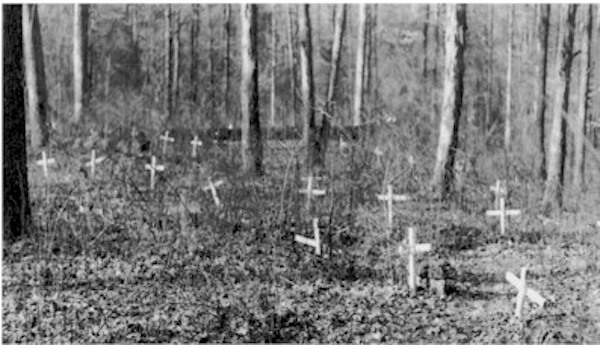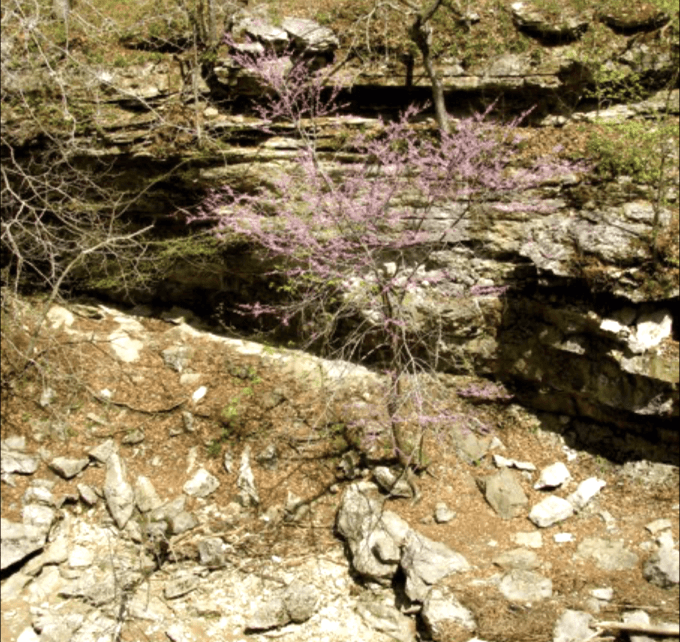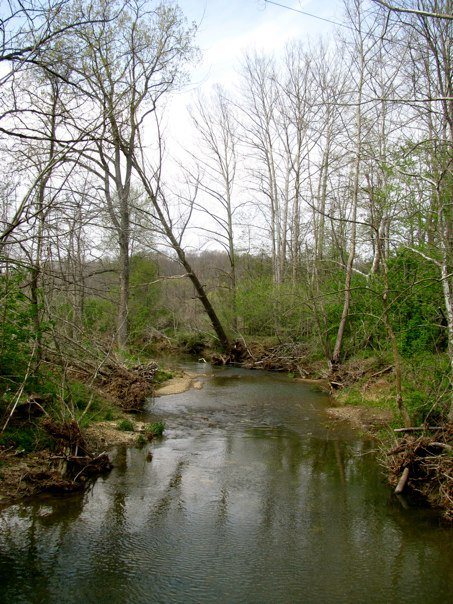
Andy Mahler at home at the Lazy Black Bear in southern Indiana. Photo: Steven Higgs.
A few miles outside the town of Paoli, in the unglaciated hill country of southern Indiana, there’s a 90-acre grove of old-growth hardwood forest called Pioneer Mothers. From 1816 to 1940, the land had been owned by the Cox family, who refused to log even a tree from the grove of titanic oaks, hickories, beech and tulip poplars. However, after the last of the Cox family died, the forest was sold to a local timber company, which planned to clearcut it. A local uprising ensued, led by some of the community’s most prominent women, who raised money to buy the property and donate it to the US Forest Service on the condition the forest would never be logged. The grove, which was named Pioneer Mothers in their honor, is now a Research Natural Area on the Hoosier National Forest and is one of only a handful of remaining old-growth groves in the Ohio Valley.
Forty-five years later another local revolt would take place in the same rural county over plans to clearcut the Hoosier National Forest. This uprising would be led by a man who lived not far from the Pioneer Mothers grove with his wife, Linda Lee, on an inholding inside the national forest, they called the Lazy Black Bear. His name is Andy Mahler, a descendant of the Bohemian composer. The son of academics, Mahler grew up in Bloomington, about 45 miles north and an entire cultural epoch away from Orange County, Indiana. Linda was a school teacher and Andy ran the farm. The couple spent much of their free time riding horses on the forest trails near the Lazy Black Bear. Then in 1985, Andy learned that the new management plan for the Hoosier National Forest had scheduled clearcuts and logging roads on the local trail network. Lots of clearcuts and as many as six miles of logging roads per square mile of land.
And that wasn’t all. The plan also called for oil and gas drilling, gypsum mining and 115 miles of Off-Road Vehicle (ORV) trails. Reflecting the usual cultural insensitivity of the Forest Service, some of the ORV trails were slated for a part of the forest called Little Africa, which received its name from one of the earliest settlements of free blacks and escaped enslaved people in Indiana along Lick Creek. The forest settlement was a refuge from the slave patrollers who roamed southern Indiana looking to kidnap black people and sell them south of the Ohio River. By the time of the Civil War, dozens of black families, along with some white Quakers, lived in the hollow, where the center of the community was the African Methodist Church. After the war, black families began to move out of Orange County to the cities, where jobs were more plentiful and racial animosity less fervent. By 1902, the last black family in Little Africa had sold their land and much of the area, including the ruins of the church and cemetery, was eventually acquired by the Forest Service. In 1985, the agency thought it might be a good idea to turn the entire area into a haven for dirt bikes.

African American cemetery at the Lick Creek (Little Africa) settlement. Photo: Forest Service.
The Forest Service, an agency whose arrogance rivals that of the Pentagon, had no idea of the political landmines it was setting for itself. But it soon found out, the hard way. The Agency was accustomed to encounters with environmentalists from Indianapolis and Bloomington, who’d waged a bruising 10-year-long battle in the 70s and early 80s to win a wilderness designation for a 13,000-acre roadless tract south of Bloomington named after the botanist Charles Deam. But they’d never had to confront a backwoods rebellion from the people who lived in and near the forest. And that’s exactly the kind of rebellion Andy Mahler set about igniting, when he formed a local group to fight the Forest Service called Protect Our Woods or POW.
At less than 200,000 acres (about the size of some ranger districts in the West), the Hoosier is one of the smallest national forests in the country. It doesn’t have sprawling tracts of old-growth forest. It doesn’t have any large predators. It doesn’t have any mountains or whitewater rivers. None of that matters to the forest’s defenders, who note that its ridges and hollows, seeps and rock shelters harbor an astonishingly high level of botanical diversity.
Mahler was able to read and understand the dense and impenetrable prose of the Forest Service plan and Environmental Impact Statement (EIS) and explain what it meant in plain language to the people who lived near the forest and hiked and rode horses on its trails, hunted for morels and chanterelles in its hollows, watched the migration of warblers stream through in the spring and the colors of the hills some called the Little Smokies explode in blazing colors in the fall.
But the struggle for the future of the Hoosier Forest soon took on national implications. It was the first plan under the National Forest Management Act to be released in the Eastern Region. The fate of the Hoosier plan was going to set a precedent and the precedent Andy Mahler wanted to set was the end, not just of clearcutting, but the end of logging on national forest lands.
What became known as the Zero Cut movement began in southern Indiana and that scared the hell out of the top level bureaucrats in the Forest Service, then in the grips of the chainsaw mad Reagan administration, most of whom probably couldn’t find the Hoosier on a map.
Mahler and his pals in the backwoods knew some vital things that the Forest Service didn’t. First, locals, even in the most conservative redoubts of a very conservative state, didn’t like seeing their favorite haunts logged and they didn’t trust the Agency to tell them the truth about what they were up to. Also, Andy’s friend Bob Klawitter, a former IU professor who decamped to woods during the Vietnam War, had done a forest inventory of the Hoosier region showing there was more than enough forest on private lands to sustain the needs of the local industry and that subsidized timber sales on federal forests would only depress the price nearby private landowners could get for their timber. Finally, Mahler was able to convince his local Congressman, Frank McCloskey, to include in one of his constituent mailers a survey that asked whether they supported logging on the Hoosier National Forest: 69% said no and the opposition approached 79% for those under the age of 35. “We knew then, we were really on to something,” Mahler said.
Mahler was right. The Hoosier plan was dead, vanquished by an unlikely coalition of urban greens, back-to-the-landers and rural folk. Commercial logging came to an end on Hoosier for the next 30 years. The racist ORV plan was defeated, along with the obnoxious oil and gas leasing and mining projects.

Redbud and rock shelter, Hoosier National Forest. Photo: Jeffrey St. Clair.
As the Forest Service began to freak out over the implications of the defeat of their plan for the Hoosier, Mahler began to broaden his vision. The precedent being set, he was eager to extend it. “We began to think bioregionally,” Mahler said. “The boundaries between these forests, and even the states, are artificial. My friend Leah Garlotte said, ‘A river isn’t a border, it’s the heart, the bloodstream of a forest ecosystem.’”
Out of this idea, Heartwood was born. Andy and Linda decided to go wherever people in the Ohio Valley were resisting the Forest Service. “Even if it was one or two people, we wanted to meet them, learn from them and join forces,” Mahler said. The search took them to the Wayne National Forest in southern Ohio and the Daniel Boone NF in northern Kentucky, the Shawnee NF in southern Illinois and the Mark Twain NF in the Ozarks of Missouri. “When we’d finally meet, it was often at the end of what Linda and I began to call a Heartwood driveway,” Mahler said. “A rutted gravel lane that winds through the woods for a quarter of mile to a cabin.”
The gospel Andy was spreading was the end of logging on federal forests and that the movement that could end it was going to be led by the people who lived in and near those forests. The other message Andy delivered to anyone who would listen, and more and more activists were, was that in order for people to trust Heartwood they couldn’t compromise on their vision. “We weren’t going to sell out,” Mahler said. “We weren’t ever going to be complicit in the destruction of forests.”
The next precedent was set on the Shawnee National Forest, where after a bitter struggle to stop the Fairview timber sale, which involved 79-day occupation, mass arrests and a Forest Service logging operation over the objections of the entire Illinois congressional delegation, a permanent injunction banned logging on the forest for the next 17 years. There is now a movement to make the Shawnee the nation’s first national park and climate preserve.
Even as Heartwood expanded into the Alleghenies, Adirondacks, Appalachians and beyond, its heart remained back in Indiana, where bi-annual gatherings of activists convene for a long weekend of workshops, war storytelling and music at the Lazy Black Bear. These forest councils are where old campaigns were celebrated and new ones born.
The problem, of course, is that few victories are permanent. As David Brower said, “Our opponents’ victories are usually forever. When we win, it is usually just a stay of execution. That’s why we need to be eternally vigilant.” And so it is with Andy Mahler. Thirty years after crushing the Forest Service and ending commercial logging on the Hoosier, the Agency is striking back, right in Andy and Linda’s backwoods. In the fall of 2021, the Forest Service unveiled a massive logging, burning and road-building scheme across a 30,000-acre area known as Buffalo Springs. Though the name Buffalo Springs doesn’t appear on any known map of the region, it didn’t take Andy long to detect that the logging and burning was scheduled to take place just down the road from the Lazy Black Bear.

Little Blue River, Hoosier National Forest. Photo: Jeffrey St. Clair.
So the old warhorse was summoned out of his stable for one last big fight to protect the forests of southern Indiana. Mahler went to work, doing what he’d done so many times in the past, pouring over the plans, deciphering the new coded language of the Forest Service, where the clearcuts of old were now dressed up as “vegetative treatments” for the seemingly benign purpose of ecological restoration. But it was clear: this project was more of an ecological blitz than a recovery plan that threatened, among others, two endangered species of bats that inhabit the caves of the world’s greatest karst geological zones.
Mahler knew that even after 30 years, people’s attitudes about logging or the Forest Service hadn’t changed. They didn’t like the former and didn’t trust the latter. And many were even more incensed about the agency’s newest menace: prescribed burning–the choking smoke from previous burns had sickened several residents so badly they had to be taken to the hospital. After months of outreach and organizing, the opposition to the sprawling assault on Buffalo Springs began to solidify. Protect Buffalo Springs signs sprouted up in nearly every yard and business across Orange County. Banners were draped from buildings in downtown Paoli and a billboard denouncing the plan greeted travelers on Highway 37, the main north-south corridor through the Hoosier National Forest.
Eventually, the county commissioners came out against it, including three Trump supporters. The Chamber of Commerce now opposes it. And, most significantly of all perhaps, the Farm Bureau, rarely an ally and usually a fearsome foe of environmentalists, announced its displeasure with the Forest Service’s Buffalo Springs plan.
The battle isn’t over. But the odds have shifted and the Forest Service knows it. So the agency may recalibrate and await an opportunity to strike again. But Andy Mahler and Heartwood aren’t going anywhere. This forest is, after all, where they live and its very existence is why they live there.
In recognition of his fearless and innovative approach to grassroots activism in the effort to protect forests, rivers and wildlife across the Central Hardwood region Andy Mahler was named the Grassroots Activist of the Year for 2024 by the Fund for Wild Nature, whose board I’m very glad to be a member of.
Source: counterpunch.org


